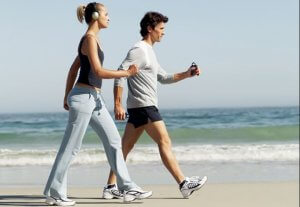The Basics of Power Walking

At first glance it might sound absurd but, did you know that walking is not as easy as it seems? Next, we’ll tell you more about power walking, an activity that consists of just that, walking. Keep reading to learn more about the basics of power walking.
Firstly, you must know that this discipline is not the same as walking to your job or to the supermarket. This is a physical activity that you can do as part of your cardio sessions. You should also maintain a balanced diet to complement it.
What is power walking?
You might not have heard of this term before, but power walking is an activity that is becoming more and more popular. Power walking consists of walking but doing it with a speed faster than your typical pace. This means that you don’t walk how you would regularly walk.
With power walking, you can improve your endurance, physical shape, and tone up your muscles. To achieve this, you must walk at medium to high speed, with no breaks, and for a specific duration.
This activity is also recommended for athletes taking a rest day or for those that for any reason cannot practice high-intensity exercises.
If you want results, it’s important that you practice this activity correctly. It’s also essential to complement it with a healthy diet adapted to this specific sport.

The main characteristics of this sport are:
- Sessions lasting between 45 minutes to an hour
- A rhythm of 9km/h. A fast pace, without running
- At least one foot must always be in contact with the ground
- Posture is essential, you must keep your back straight, contract your abdomen and keep your eyes looking forward
What is the best diet to follow?
As we previously mentioned, power walking helps you to stay in shape and tone your muscles. Many people start practicing this sport to reach their ideal weight.
In order to reach your goals faster and to improve your health, you must eliminate sugary drinks, fast foods and pre-cooked meals from your diet.
Even if power walking is a low-intensity exercise, it’s important to keep yourself hydrated. We recommend you drink water before you start your session. If you’re planning on completing sessions longer than half an hour, you must carry a bottle of water. Take small sips of water regularly to compensate for sweating.
If your power walking sessions are longer than one hour, you must also carry a snack. Eating a snack that’s rich in carbohydrates will give you extra energy.
Benefits of power walking
Power walking has many health benefits. Next, we’ll tell you about the main benefits of this activity. You will be surprised that such a simple activity can be so beneficial.
Weight-loss
Power walking is an easy way to lose weight. Since it’s a low-intensity exercise, we recommend you walk several times a week in order to see results.
Stress relief
We all experience overwhelming routines. Work and family tend to be the main sources of stress. One effective way of clearing your mind and relaxing is power walking. After a session, you’ll notice that you’ll return home feeling much calmer.

Muscle toning
After a few weeks of regularly practicing power walking, you’ll also notice how well your muscles are toning up. Your calves and glutes, the muscles that you engage the most when walking, will look particularly toned.
Now that you know about power walking and its benefits, there’s no excuse to not start practicing it. You will de-stress, relax and get in shape while doing it. Don’t wait any longer, head out the door for a walk!
At first glance it might sound absurd but, did you know that walking is not as easy as it seems? Next, we’ll tell you more about power walking, an activity that consists of just that, walking. Keep reading to learn more about the basics of power walking.
Firstly, you must know that this discipline is not the same as walking to your job or to the supermarket. This is a physical activity that you can do as part of your cardio sessions. You should also maintain a balanced diet to complement it.
What is power walking?
You might not have heard of this term before, but power walking is an activity that is becoming more and more popular. Power walking consists of walking but doing it with a speed faster than your typical pace. This means that you don’t walk how you would regularly walk.
With power walking, you can improve your endurance, physical shape, and tone up your muscles. To achieve this, you must walk at medium to high speed, with no breaks, and for a specific duration.
This activity is also recommended for athletes taking a rest day or for those that for any reason cannot practice high-intensity exercises.
If you want results, it’s important that you practice this activity correctly. It’s also essential to complement it with a healthy diet adapted to this specific sport.

The main characteristics of this sport are:
- Sessions lasting between 45 minutes to an hour
- A rhythm of 9km/h. A fast pace, without running
- At least one foot must always be in contact with the ground
- Posture is essential, you must keep your back straight, contract your abdomen and keep your eyes looking forward
What is the best diet to follow?
As we previously mentioned, power walking helps you to stay in shape and tone your muscles. Many people start practicing this sport to reach their ideal weight.
In order to reach your goals faster and to improve your health, you must eliminate sugary drinks, fast foods and pre-cooked meals from your diet.
Even if power walking is a low-intensity exercise, it’s important to keep yourself hydrated. We recommend you drink water before you start your session. If you’re planning on completing sessions longer than half an hour, you must carry a bottle of water. Take small sips of water regularly to compensate for sweating.
If your power walking sessions are longer than one hour, you must also carry a snack. Eating a snack that’s rich in carbohydrates will give you extra energy.
Benefits of power walking
Power walking has many health benefits. Next, we’ll tell you about the main benefits of this activity. You will be surprised that such a simple activity can be so beneficial.
Weight-loss
Power walking is an easy way to lose weight. Since it’s a low-intensity exercise, we recommend you walk several times a week in order to see results.
Stress relief
We all experience overwhelming routines. Work and family tend to be the main sources of stress. One effective way of clearing your mind and relaxing is power walking. After a session, you’ll notice that you’ll return home feeling much calmer.

Muscle toning
After a few weeks of regularly practicing power walking, you’ll also notice how well your muscles are toning up. Your calves and glutes, the muscles that you engage the most when walking, will look particularly toned.
Now that you know about power walking and its benefits, there’s no excuse to not start practicing it. You will de-stress, relax and get in shape while doing it. Don’t wait any longer, head out the door for a walk!
All cited sources were thoroughly reviewed by our team to ensure their quality, reliability, currency, and validity. The bibliography of this article was considered reliable and of academic or scientific accuracy.
- Palacios, N., Montalvo, Z., & Ribas, A. M. (2009). Alimentación, nutrición e hidratación en el deporte. Consejo Superior de Deportes (Vol. 165, p. 26). https://doi.org/10.1016/j.jad.2014.04.038
- Tur, J., & Pons, A. (2006). Nutrición y Deporte. In Masson-Elsevier (Ed.), Nutrición y Salud Pública(Vol. 36, pp. 337–346). Retrieved from http://cvapp.uoc.edu/autors/MostraPDFMaterialAction.do?id=168663
- Palavecino, N. (2002). Nutrición para el alto rendimiento. Colección Ciencias de la salud (Vol. I, p. 388). España: Libros en Red. https://doi.org/10.1007/BF00440365
This text is provided for informational purposes only and does not replace consultation with a professional. If in doubt, consult your specialist.








